OIP Reboot: Resetting Ohio's Foundation for Improved Student and Adult Learning
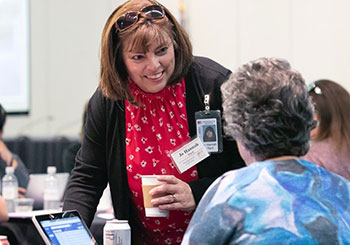
Originally designed in 2007 as Ohio’s framework for supporting district-wide continuous improvement, the Ohio Improvement Process (OIP) is undergoing revision (what might be called a “reboot”) to make refinements in core processes and resources. The reboot will improve the usability of the OIP as a strategy for supporting district-wide implementation of evidence-based practices that improve teaching and learning for all children.
Used by a majority of Ohio school districts and community schools, the OIP is accessible to all districts and broadly applicable to improvement work. It provides a common framework for all regional providers (e.g., state support team personnel) to use in supporting districts in their regions, and it positions Ohio’s statewide system of support (SSoS) to provide high-quality, consistent support to any district, regardless of where that district is located in the state. Ohio’s SSoS is inclusive of SSTs, ESCs, and other regional and state entities such as institutions of higher education.

“The OIP is not compliance-focused; it’s an organizational strategy,” said Jo Hannah Ward, director of the Ohio Department of Education’s Office for Improvement and Innovation. “The official reboot resets the foundation of the OIP across the statewide system of support and sets the expectations for all regional personnel to more effectively contribute to one stronger, more coherent support system for districts,” she added.
One System: Improving Quality, Consistency, & Coherence in Statewide Support
OIP produced significant impact during its first decade. So under the reboot, its core elements will remain unchanged. The OIP provides both the structures and the major tools that all districts can use to make and sustain instructional improvements, regardless of the improvement status of the district or the needs of individual schools within the district.
Heather Thompson
Principal, Western Primary School
Western Local Schools
Collaborative Structures. As a foundational strategy, the OIP makes use of aligned collaborative learning teams at the district, school, and classroom level.1 These teams provide common structures for supporting meaningful instructional discourse among educators with multiple perspectives and areas of expertise.
Collaborative teams also provide the forum for shared learning among educators (e.g., teachers, principals, central office personnel, related services providers, paraprofessionals, and so on) who have a role in improving teaching and learning, supporting districts in building their professional (human capital), and strengthening system capacity for continuous learning and growth.
“Following a continuous improvement process keeps conversations focused, facilitates communication and decision-making as an interactive coherent process that occurs between all levels of the system, forms a peerto- peer network that fosters collective learning and inclusiveness, and allows for the highest return on teams’ investment of time,” explained Ward.
Heather Thompson, principal of Western Primary School in Pike County, agrees stating:
“The OIP collaborative structures are most essential to supporting adult implementation and student learning because by working together we come to consensus or a collective decision-making process about what we’re going to do and how to implement it. Teachers can bring back ideas to the team about what worked for them and feel like they’re not in a silo by themselves; they have other people to support them. The structures allow for developing those leaders among the teams who can help push their team’s thinking and stay focused. We don’t always have all the answers but together we can become better at what we do. Without the framework and structures put in place by OIP, we may not experience this learning and those leaders may not come forward.”
Ohio’s Statewide System of Support (SSoS)
The substantive goal of Ohio’s statewide system of support (SSoS) and, by extension, the state support team (SST) network that is its foundation, is to build the capacity of all districts (including community schools) to provide every child/youth with equitable opportunities to learn.
Its operational goal is to improve the learning of children/youth through the use of inclusive instructional practices that support students’ development of foundational knowledge and skills, competence with well-rounded academic content, leadership and reasoning skills, and social-emotional learning – critical domains represented in Ohio’s new strategic education plan. Ohio’s SSoS views districts – and all schools within the district – as the unit of change and improvement.
Click here for more information about Ohio’s strategic education plan.
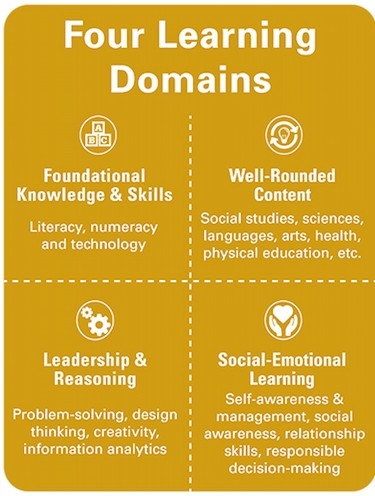
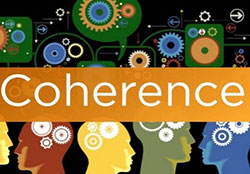
Connected Tools. The OIP is also built around the use of a common and aligned set of web-based tools, such as the Decision Framework, which support teams in setting parameters for their work and in communicating and making decisions about what is and is not working across the district. The OIP’s major tools interact with each other in a web-based environment and, along with support documents keyed to various steps of the OIP process, are used by districts to:
- Reduce the number of duplicative and often conflicting priorities;
- Reduce isolated and often disjointed practice;
- Increase coherence across the district; and
- Use state and federal funds to implement a unified and focused district-wide plan for improving instructional practice and student learning.
As described in Resetting the Foundation of Ohio’s Statewide System of Support (2018), increased focus and coherence can be achieved through the use of OIP structures and tools. Helping districts gain focus – a major role of regional providers – allows them to implement priorities across the system, avoiding the proliferation of strategies.
Aligning the core work of the district – across schools within the district and across classrooms within each school – increases coherence and guards against the incompatibility of strategies within and across levels of the system.
Focus and coherence are necessary for making and sustaining critical improvements on behalf of all students, and all districts – regardless of improvement status – can improve.
Improvement is everyone’s business!
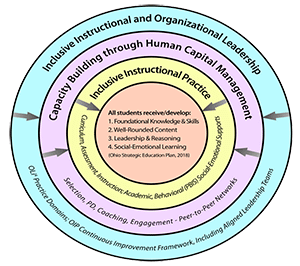
Keeping the Larger Purpose in Mind: OIP as an Organizational Strategy:
Ohio’s approach to supporting districts in making meaningful system improvements that result in deeper levels of learning for all children centers on three major areas of practice:
- Inclusive Instructional and Organizational Leadership that fosters a culture of inquiry and continuous learning on the part of all district personnel in order to provide equitable access to highquality instruction and support for all children in every classroom in every school across the district;
- Human Capital Management that builds the capacity of the district to address its fundamental goals, including the recruitment, selection, onboarding and deployment of all personnel, and the provision of ongoing support to all personnel in the use of service delivery models that improve equitable access to high-quality instruction and support for all children; and
- Inclusive Instructional Practice that ensures equitable access to high-quality instruction and support, and improves learning outcomes for all children.
Theory of action. These three inter-related areas of practice (shown above) have in common the fundamental purpose of supporting districts and their schools in providing equitable access to high-quality instruction and support for every child in every school within the district. They also provide the building blocks of a theory of action that goes something like this:
If our goal is to ensure that every Ohio child/youth receives well-rounded content and develops foundational knowledge and skills, leadership and reasoning skills, and is supported in social emotional learning, then each child/youth must be taught through the use of effective inclusive instructional practices; and
If each child/youth is to be taught through the use of inclusive instructional practices, then the district must ensure that all district and school personnel (i.e., their human capital) have the capacity to use such practices; and
If every educator in every school within the district is to develop competence in the use of inclusive instructional practices, then they must be supported in doing so by leaders (e.g., central office personnel, principals, teacher leaders, others) who understand and can apply inclusive instructional and organizational leadership.
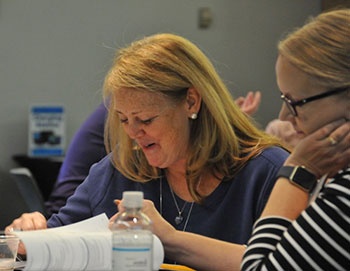
Ohio has long recognized that working with one or two buildings in a district cannot lead to sustainable improvement. Instead the SSoS must work with districts, by supporting effective and equitable district policies, practices, and decisions. Only when a district mobilizes around systemic improvement can progress be made and sustained within its schools. Supporting classrooms to the exclusion of schools, and supporting schools to the exclusion of the district, undermines the goal of ensuring equitable opportunities to learn for every child. Ensuring equitable opportunities to learn and providing the supports needed to learn should be guaranteed to each child no matter what classroom and school that child attends. That’s why the system of support is statewide.
Focusing Expertise Using a Common Approach. State support team (SST) personnel support districts in continuously and systematically improving instructional practice through the use of a variety of evidence-based instructional frameworks, methodologies, and strategies. Among these are (1) the PBIS framework; (2) the UDL framework; and (3) evidence-based instructional strategies including early language and literacy instruction, academic and behavioral interventions). Particular frameworks, methodologies, and/or strategies are applied when (and only when) they make sense in responding to districtidentified needs.
“We don’t expect SSTs to be expert in everything; these are resources for their toolbox that they can draw on in supporting districts,” explained Ward. For regional providers to be on the same page in supporting districts, we need to have a common vocabulary and use common tools so we can share and capitalize on each other’s expertise in and outside the agency. This will be first time that the agency is unified in its attempts to connect support throughout agency and at the regional and local level,” she added.

To support a common approach to providing support, SSTs need a common set of measures to use in gauging the impact of their work with districts in each of the three areas of practice. These measures also provide the state with a way to assess the health of the SSoS, answering key evaluation questions such as, “are the goals of the system being met?” The Moving Your Numbers (MYN)2 District Organizational Practices Inventory will be the first measurement tool used for the purpose of gauging progress in the area of inclusive instructional and organizational leadership. MYN focuses on promoting system-wide learning, prioritizing the improvement of teaching and learning, building capacity through support and accountability, and sustaining an open and collaborative culture.
Improvement Technologies. In addition to using educational frameworks (e.g., UDL), SST personnel also will use improvement models or technologies (e.g., implementation science, improvement science) to support districts in identifying and honing in on practices to be used, in fully implementing those practices, and in learning from implementation efforts in order to make and sustain meaningful improvements. “We spent the last two years developing SST capacity around implementation science and supporting their use of implementation science principles and tools in their work with districts,” said Ward. “For example, are the right drivers in place and considered to support districts and are districts able to act on their identified ‘it,’ that is, whatever evidence-based strategy they choose to implement,” she added.
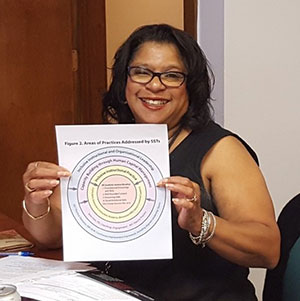
"Incorporating principles of implementation science into the work of the SSTs provides them with additional tools and resources to use as they support districts in fully implementing inclusive instructional and organizational leadership practices such as those delineated in Moving Your Numbers. Moving Your Numbers is closely aligned with implementation science and provides examples and lessons learned, illustrating how districts can improve results for all children by attending to both the depth or extensiveness of implementation as well as the breadth or extensiveness of implementation across schools in the district," explained Dr. Michelle Duda, Sr. Board Certified Behavior Analyst and President of the Florida-based Implementation Scientists, LLC.3
Rather than promote particular frameworks or approaches, SST personnel help districts think about the best fit in terms of addressing identified needs. Questions like those shown below help districts make critical connections, avoid fragmentation, and stay focused on their most critical needs. They also help districts stay focused on their goals and how activities designed to meet their goals can collectively affect outcomes for all children.
“Our effort to refine the OIP is about fostering a deeper integration of strategies to improve core instruction and deeper learning for each child, as opposed to operating within traditional and often separate silos to address the needs of groups of students, such as students with disabilities or English learners,” offered Ward. “In this way, we’re better situated to not only meet ESSA, IDEA, and state requirements, but to go teach and support every child.”
Framework Dimensions
- Pre-established vs district-developed framework
- Breadth and depth of districtwide priorities addressed by the framework
- Level of autonomy of framework use at the school-level
Suggested Questions
- What are the optimal uses of the framework (i.e., what is the framework good for)?
- Who are the intended beneficiaries of the framework (i.e., who is the framework good for)?
- At what level is the framework best used?
- What level of resources (personnel, programmatic, fiscal) is needed to support effective and sustained use of the framework?
Online resources available at no cost through the OLAC website – including modules, webinars, workshops, and a variety of related resources – are relevant and useful for all educators, not only administrators, and are aligned with Ohio’s approach to improvement. These resources, which comprise a primary source of information for SSTs to use in supporting district-wide continuous improvement, are currently housed on the OLAC site and will be updated to reflect refinements made through the OIP reboot and available through OLAC during the 2018- 19 school year.
Getting Smarter About Service Delivery: Universal, Targeted, & Comprehensive Support
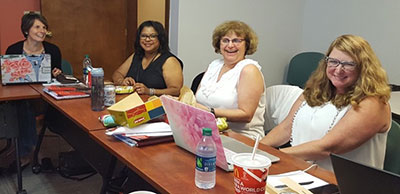
SSTs have long relied on the use of a multi-tiered model for planning and delivering services to districts in their regions. However, as shown below, the OIP reboot further defined the types of services and delivery methods that could be characterized as universal (tier 1), targeted (tier 2), and comprehensive (tier 3).
Ward explains: “We needed to reestablish our SSoS tiered model to describe who gets what support, when, and at what level of intensity and duration based on the need and context of the district. If we try to build TBTs with every BLT in every school that needs support, we’d never be able to sustain or support that kind of effort; instead, we need to build the capacity of districts to direct and support their BLTs and TBTs.”
Customizing Support Using OIP. Decision rules for guiding the delivery of SST services were discussed by SST personnel during an August 2018 meeting. These include the requirement that SSTs dedicate a minimum of 90% of their human and fiscal resources to supporting the districts with the greatest need (i.e., those deemed to be comprehensive and targeted) as determined by the state. The remaining 10% can be used to provide universal support to all districts – irrespective of improvement status – and other organizations in their regions.
SST Tiered Service Delivery Model
| Essential Attributes | Tier III: Comprehensive | Tier II: Targeted | Tier I: Universal |
|---|---|---|---|
| Level of Service Intensity & Duration | High | Moderate | Low |
| Tier Characteristics |
|
|
|
| Service Delivery Methods |
|
|
|
| Areas of Practice |
|
|
|
Comprehensive districts include:
- Districts identified as intensive;
- Districts identified by ODE’s Office for Exceptional Children as needing intervention/substantial intervention;
- Districts in academic distress commission (ADC) status;
- Early literacy pilot districts;
- State Personnel Development Grant (SPDG) districts; and/or
- Districts, ESCs, career centers, or county boards of developmental disabilities (DD) identified through selective review conducted by ODE-OEC.
Western Primary School in Western Local Schools receives intensive support from the Regional Early Literacy Specialist (RELS) in SST Region 15. One of a small number of districts and schools participating in Ohio’s early literacy pilot, teachers at Western Primary are participating in LETRS4 professional development to improve their early literacy and language instruction.
“We had the support of the SST and a district literacy coach, which has been a huge component. We dedicated ourselves to a focus, which made our use of the OIP more meaningful. Having all team members present through grade-level TBTs to offer support for students has allowed intervention staff to connect intervention to what’s happening in core instruction. OIP structures have also allowed for vertical discussions and decision making. For example, if we look at data and see that a majority of second graders are struggling with a specific skill area, our BLT can identify gaps, address the needs, and share solutions across TBTs,” explained Thompson.
Jo Hannah Ward
Director, Office for Improvement and Innovation
Ohio Department of Education
Owning the System. Under the leadership of Ward and her colleagues at ODE, Ohio has made progress in developing a more unified approach and a more integrated system. “We’ve built Ohio’s system in partnership with many organizations and associations. It’s not a compliance mandate, but rather a shared system of support at all levels of the educational cascade,” observed Ward.
“Bringing ESCs on board will add depth and expertise and allow for more capacity in meeting the needs of districts. A truly integrated collaborative statewide system of support must involve SSTs and ESCs working together in the service of districts, schools, and children. Improvement really is everyone’s business,” she added.
References
Ohio’s leadership development framework (2nd ed.). (2013). Columbus, OH: Buckeye Association of School Administrators (BASA).
Resetting the Foundation of Ohio’s Statewide System of Support. (2018). Columbus, OH: State Development Team, University of Cincinnati, College of Education, Criminal Justice, Human Services, and Information Technology, Systems Development & Improvement Center.
Resources of Interest
Bryk, A. S., Gomez, L. M., Grunow, A., & LeMahieu, P. G. (2017). Learning to improve: How America’s schools can get better at getting better. Cambridge, MA: Harvard Education Press.
The Center on School Turnaround. (2017). Four domains for rapid school improvement: A systems framework [The Center for School Turnaround at WestEd]. San Francisco, CA: WestEd Retrieved from https://centeronschoolturnaround.org/resource/four-domains-for-rapid-school-improvement-a-systems-framework/.
Duda, M. A., & Wilson, B. A. (2015). Using implementation science to close the policy to practice gap. A literate nation white paper, science panel. San Francisco, CA.
Ezzani, M. (2015). Coherent district reform: A case of two California school districts. Cogent Education, 2: 1018698.
Fullan, M., & Hargreaves, A. (2012). Reviving teaching with ‘professional capital.’ Education Week, 31(33), 30, 36.
Fullan, M., Rincon-Gallardo, S., & Hargreaves, A. (2015). Professional capital as accountability. Education Policy Analysis Archives, 23(15). Retrieved from http://dx.doi.org/10.14507/epaa.v23.1998.
Hannay, L., Jaafar, S. B., & Earl, L. (2013). A case study of district leadership using knowledge management for educational change. Journal of Organizational Change Management, 26(1), 64-82.
Hargreaves, A., & Fullan, M. (2012). Professional capital: Transforming teaching in every school. New York, NY: Teachers College Press.
Honig, M. I., Copland, M. A., Rainey, L., Lorton, J. A., & Newton, M. (2010). Central office transformation for district-wide teaching and learning improvement. Seattle, WA: University of Washington, Center for the Study of Teaching and Policy.
Louis, K. S., Leithwood, K., Wahlstrom, K. L., & Anderson, S. E. (2010). Learning from leadership: Investigating the links to improved student learning. Center for Applied Research and Educational Improvement/University of Minnesota and Ontario Institute for Studies in Education/University of Toronto.
McNulty, B.A., & Besser, L. (2014). Leaders make it happen! An administrator’s guide to data teams. San Diego, CA: Houghton Mifflin Harcourt.
1 District leadership teams (DLTs), building leadership teams (BLTs), and teacher-based teams (TBTs). For more information, see Ohio’s Leadership Development Framework, accessible from at the Ohio Leadership Advisory Council (OLAC) website at: www.OhioLeadership.org.
2 Moving Your Numbers is a national initiative sponsored by the University of Minnesota National Center on Educational Outcomes and coordinated through the UC Systems Development & Improvement Center. For more information, go to www.movingyournumbers.org.
3 For more information, contact Dr. Duda at www.behaviorhappens.com.
4 LETRS is Language Essentials for Teachers of Reading and Spelling.
For More Information
For more information about the OIP reboot and Ohio’s Statewide System of Support, contact Jo Hannah Ward, Director, Office for Improvement and Innovation, Ohio Department of Education, at 614.745.5365, or via email JoHannah.Ward@education.ohio.gov.
For more information about Western Primary School’s use of the OIP to improve early language and literacy instruction, contact Heather Thompson, Principal, at 740.493.2881, or via email at hthompson@westernlocalschools.com.
For more information about the OLAC and OIP resources, contact Dr. Jim Gay, OLAC Co-director, at jimgay@basa-ohio.org; or Karel Oxley, OLAC Co-director, at Oxley@basa-ohio.org.